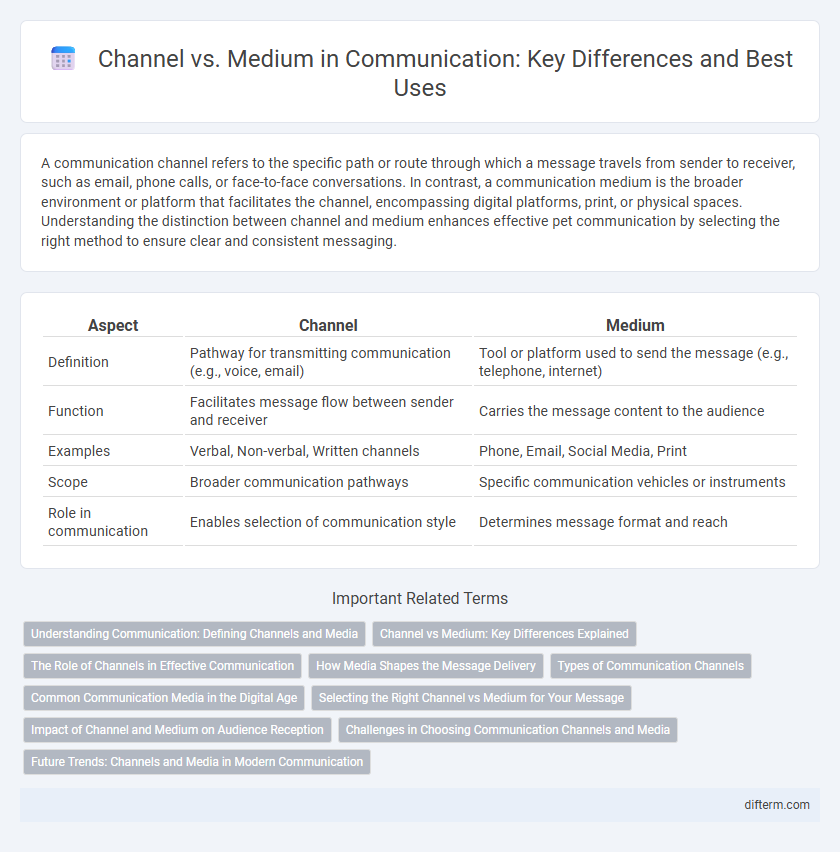A communication channel refers to the specific path or route through which a message travels from sender to receiver, such as email, phone calls, or face-to-face conversations. In contrast, a communication medium is the broader environment or platform that facilitates the channel, encompassing digital platforms, print, or physical spaces. Understanding the distinction between channel and medium enhances effective pet communication by selecting the right method to ensure clear and consistent messaging.
Table of Comparison
| Aspect | Channel | Medium |
|---|---|---|
| Definition | Pathway for transmitting communication (e.g., voice, email) | Tool or platform used to send the message (e.g., telephone, internet) |
| Function | Facilitates message flow between sender and receiver | Carries the message content to the audience |
| Examples | Verbal, Non-verbal, Written channels | Phone, Email, Social Media, Print |
| Scope | Broader communication pathways | Specific communication vehicles or instruments |
| Role in communication | Enables selection of communication style | Determines message format and reach |
Understanding Communication: Defining Channels and Media
Channels refer to the specific pathways through which messages travel, such as verbal speech, email, or social media platforms. Media encompass the tools or systems used to deliver communication, including television, radio, and digital networks. Distinguishing between channels and media enhances clarity in communication strategies by aligning the appropriate delivery method with the intended message and audience.
Channel vs Medium: Key Differences Explained
Channels refer to the physical or digital pathways through which messages travel, such as email, phone calls, or social media platforms. Mediums encompass the broader method or format of communication, including written, verbal, and non-verbal forms. Understanding the distinction between channel and medium enhances effective communication strategy by selecting the appropriate path and method for message delivery.
The Role of Channels in Effective Communication
Channels in communication serve as the pathways through which messages travel from sender to receiver, significantly influencing the clarity and impact of the information exchanged. Selecting the appropriate channel, whether verbal, non-verbal, digital, or face-to-face, enhances message effectiveness by aligning with the communication context and audience preferences. Effective use of communication channels ensures timely feedback, reduces misunderstandings, and fosters stronger interpersonal connections in both personal and professional interactions.
How Media Shapes the Message Delivery
Media shapes message delivery by determining the format and sensory experience through which information is received, influencing interpretation and engagement levels. Channels are pathways for transmitting messages, while media refer to the specific tools or platforms--such as print, radio, digital, or face-to-face--that carry the content. The choice of media impacts message clarity, reach, and emotional resonance, ultimately shaping how audiences perceive and respond to communication.
Types of Communication Channels
Communication channels include direct channels such as face-to-face conversations, telephone calls, and video conferencing that enable real-time interaction and immediate feedback. Indirect channels like emails, memos, and social media platforms provide asynchronous communication, allowing information to be shared without simultaneous presence. Selecting the appropriate communication channel depends on factors such as message urgency, audience size, and desired level of interaction.
Common Communication Media in the Digital Age
Common communication media in the digital age include email, social media platforms, instant messaging apps, and video conferencing tools, each serving as a vital channel for transmitting information. These digital media facilitate real-time interaction, broad accessibility, and multimedia integration, enhancing the effectiveness of communication channels. Understanding the distinction between channel as the pathway through which a message travels and medium as the specific tool or platform used is essential for optimizing message delivery.
Selecting the Right Channel vs Medium for Your Message
Selecting the right channel versus medium for your message depends on the audience, message complexity, and desired interaction level. Channels refer to the pathways like email, phone, or face-to-face, while mediums involve the specific tools or platforms used within those channels. Choosing the optimal combination enhances message clarity, engagement, and response effectiveness.
Impact of Channel and Medium on Audience Reception
The choice of communication channel significantly influences audience reception by determining message clarity and engagement levels, where digital platforms often enable interactive and immediate feedback compared to traditional media. Mediums such as text, audio, and visual convey varying sensory information, affecting comprehension and emotional response differently among diverse audience demographics. Effective alignment of channel and medium with audience preferences and message complexity enhances overall communication impact and retention.
Challenges in Choosing Communication Channels and Media
Selecting appropriate communication channels involves challenges such as message distortion, audience accessibility, and technological limitations, which can hinder effective information exchange. Media richness theory highlights the difficulty in matching channel capabilities with message complexity, impacting clarity and engagement. Ensuring compatibility between channel properties and communication goals remains a critical obstacle for organizations seeking optimal media strategies.
Future Trends: Channels and Media in Modern Communication
Emerging trends in communication highlight the convergence of channels and media, with digital platforms integrating multiple media types to enhance interaction and engagement. Advanced technologies such as AI-driven chatbots and augmented reality are transforming channels, enabling personalized and immersive communication experiences. The future of communication relies on adaptive channels that seamlessly deliver diverse media formats across various devices, optimizing user connectivity and content accessibility.
channel vs medium Infographic

 difterm.com
difterm.com